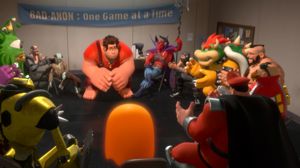The system specifications you designed for Wreck-It Ralph are solid. Fed up with the repetition and drudgery of his day job, a block-headed coin-op arcade video game villain goes rogue in an attempt to win the accolades and attention that are, by nature of his programming, beyond his reach. Classic redemption story. You have a linear journey with an integrated end-goal: Ralph proceeds to invade the other arcade games and unwittingly puts all of the machines in danger of being put out of order (the video game equivalent of an extinction-level-event). If only there was more to it than that.
When Ralph (voiced by John C. Reilly) first leaves his Mario-inspired platform jumper home, he ends up in a light-gun game called Hero's Duty. Here the film acknowledges that it takes place in a world much like ours, where friendly Italian pipe-fitters have given way to death-dealing super-soldiers. In placing an old-school character like Ralph in the middle of a hyperkinetic first-person shooter, it seemed the film might have something meaningful to say about the way children entertain themselves, and how much the mood and tenor of that entertainment has changed in the last twenty years. As much as this is a story about Ralph and Felix (voiced by Jack McBrayer) losing their innocence as they question the limitations imposed by their predestined roles as villain and hero, it also could have been a story of innocence lost on a much broader scale.
Unfortunately, that thread is never really followed.
I suppose you could argue that the beetle-creatures Ralph unintentionally smuggles out of Hero's Duty are some sort of metaphor for the threatening influence of a newer, more cynical, type of games. But Wreck-It Ralph, sadly, doesn't have such ambitions. No, there aren't that many layers between the hardware and the end-user. The software architecture, here, is pretty simple.
We get a few fun cameos from classic video game characters (who, let's be honest, the target audience of this film is too young to recognize by at least a decade), but with the entire history of video games to explore, I have to admit I was disappointed by how much time was spent lingering in the kart racing game Sugar Rush. And not just because the vibrant design of the candy-inspired racetrack world gave my eyeballs diabetes. Ralph is there to train his sidekick, the glitchy tyke Vanellope Von Swchweetz (Sarah Silverman, whose sometimes-endearing nails-on-chalkboard delivery is, here, has a certainn ear-bleeding quality), ). By the end of it all, after the secret princesses and megalomaniacal villains have been revealed, we've learned some pretty typical lessons about friendship and loyalty and believing in yourself and learning to love yourself for who you are. There's nothing new in this code.
Wreck-It Ralph is good. It works. It's functional. But it's a perfect example of how a half-developed idea_ _can't be corrected after the fact with advanced algorithms and detailed documentation. No, even in software engineering you have to be bold to be great.
Sincerely,

Jared







